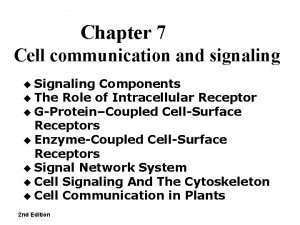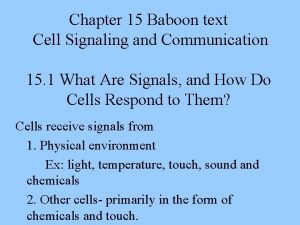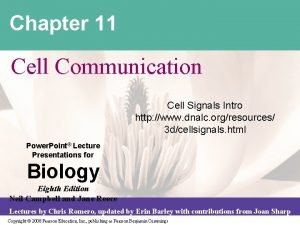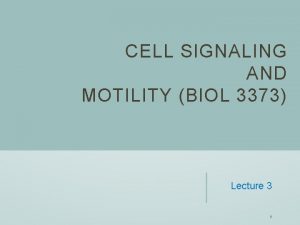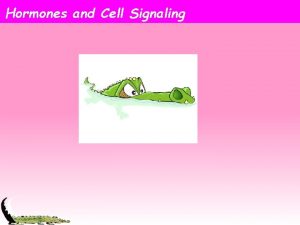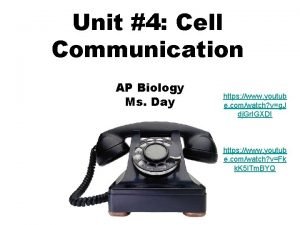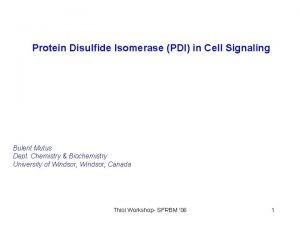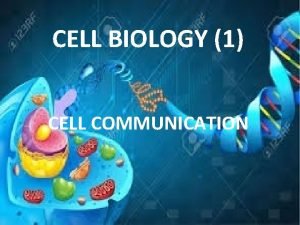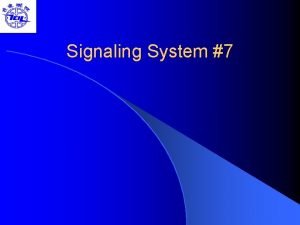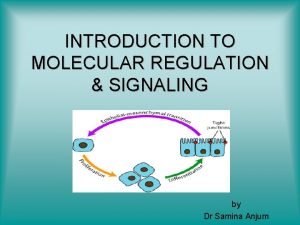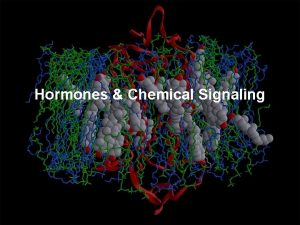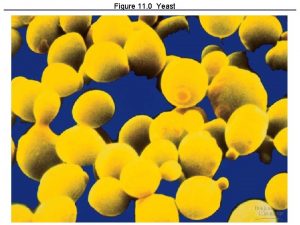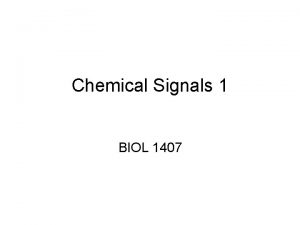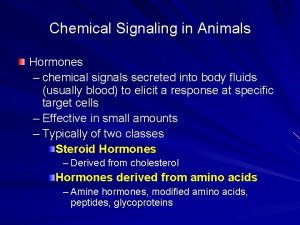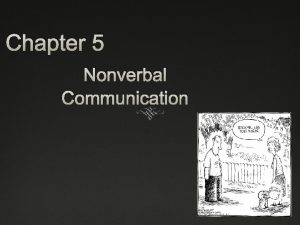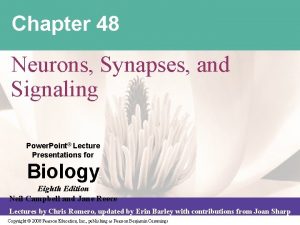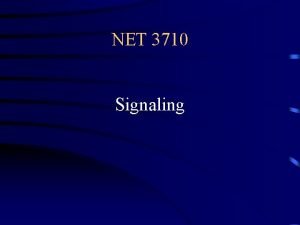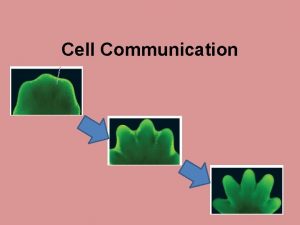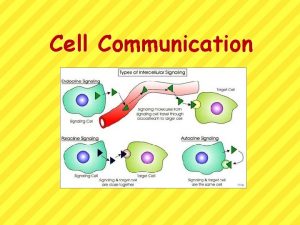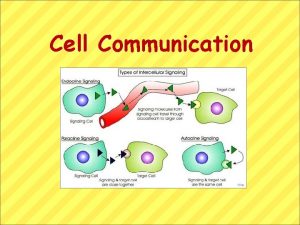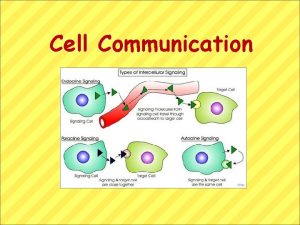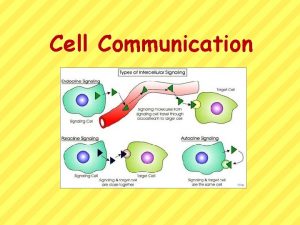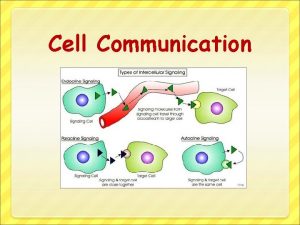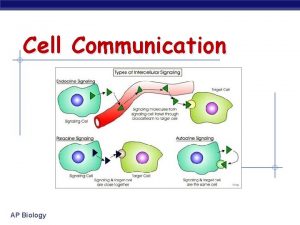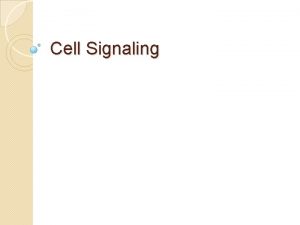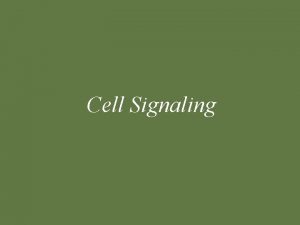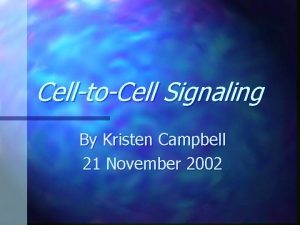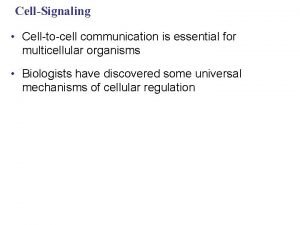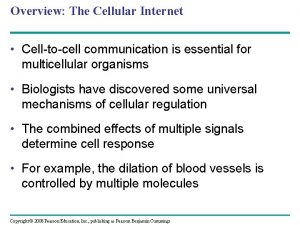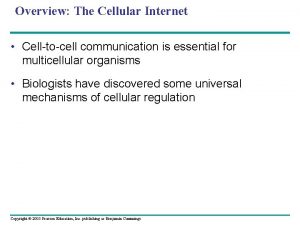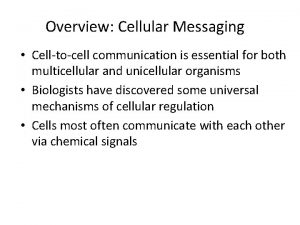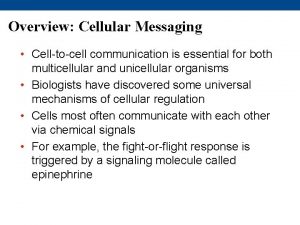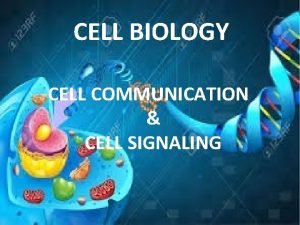Cell Communication Cell Signaling Celltocell communication is essential
























- Slides: 24

Cell Communication

Cell Signaling • Cell-to-cell communication is essential for multicellular organisms • Communicate by chemical messengers • Animal and plant cells have cell junctions that directly connect the cytoplasm of adjacent cells • In local signaling, animal cells may communicate by direct contact

Plasma membranes Gap junctions between animal cells Cell junctions Cell-cell recognition Plasmodesmata between plant cells

Signaling • Local- paracrine, synaptic signaling • Long-distance- hormonal signaling (endocrine) Local signaling Long-distance signaling Target cell Secreting cell Local regulator diffuses through extracellular fluid Paracrine signaling Electrical signal along nerve cell triggers release of neurotransmitter Endocrine cell Neurotransmitter diffuses across synapse Secretory vesicle Target cell is stimulated Blood vessel Hormone travels in bloodstream to target cells Target cell Synaptic signaling Hormonal signaling

The Three Stages of Cell Signaling • Reception • Transduction • Response

Reception • The binding between a signal molecule (ligand) and receptor is highly specific • A conformational change in a receptor is often the initial transduction of the signal • Most signal receptors are plasma membrane proteins EXTRACELLULAR FLUID Reception Receptor Signal molecule CYTOPLASM Plasma membrane Transduction

Transduction • Usually involves multiple steps • Multistep pathways can amplify a signal EXTRACELLULAR FLUID Reception CYTOPLASM Plasma membrane Transduction Receptor Relay molecules in a signal transduction pathway Signal molecule

Response Signal transduction pathways lead to regulation of one or more cellular activities EXTRACELLULAR FLUID Reception CYTOPLASM Plasma membrane Transduction Response Receptor Activation of cellular response Relay molecules in a signal transduction pathway Signal molecule

Intracellular Receptors • Some receptor proteins are intracellular, found in the cytosol or nucleus of target cells • Small or hydrophobic chemical messengers (lipid steroids) can readily cross the membrane and activate receptors • An activated hormone-receptor complex can act as a transcription factor, turning on specific genes

Hormone (testosterone) EXTRACELLULAR FLUID Plasma membrane Receptor protein Hormonereceptor complex The steroid hormone testosterone passes through the plasma membrane. Testosterone binds to a receptor protein in the cytoplasm, activating it. The hormonereceptor complex enters the nucleus and binds to specific genes. DNA The bound protein stimulates the transcription of the gene into m. RNA NUCLEUS New protein The m. RNA is translated into a specific protein. CYTOPLASM

Receptors in the Plasma Membrane • Most water-soluble signal molecules bind to specific sites on receptor proteins in the plasma membrane • There are three main types of membrane receptors: – G-protein-linked receptors – Receptor tyrosine kinases – Ion channel receptors

G-Protein-Linked Receptor • A G-protein-linked receptor is a plasma membrane receptor that works with the help of a G protein • The G-protein acts as an on/off switch: • GTP= active GDP= inactive Signal-binding site Segment that interacts with G proteins

First messenger (signal molecule such as epinephrine) Adenylyl cyclase G protein G-protein-linked receptor GTP ATP c. AMP Second messenger Protein kinase A Cellular responses

Ion Channel Receptor • Acts as a gate when the receptor changes shape Signal molecule (ligand) Gate closed Ligand-gated ion channel receptor Ions Plasma membrane Gate open Cellular response Gate closed

Signal Transduction Pathways • The molecules that relay a signal from receptor to response are mostly proteins • Behave similar to falling dominos • At each step, the signal is transduced into a different form, usually a conformational change EXTRACELLULAR FLUID Reception CYTOPLASM Plasma membrane Transduction Response Receptor Relay molecules in a signal transduction pathway Signal molecule Activation of cellular response

Protein Phosphorylation and Dephosphorylation • In many pathways, the signal is transmitted by a cascade of protein phosphorylations • Phosphatase enzymes remove the phosphates • This phosphorylation and dephosphorylation system acts as a molecular switch, turning activities on and off

Signal molecule Receptor Activated relay molecule Inactive protein kinase 1 Active protein kinase 1 P n io ad sc ca PP at Active protein kinase 2 yl Pi ADP or ATP ph os Ph Inactive protein kinase 2 e Inactive protein kinase 3 ATP Pi ADP Active protein kinase 3 PP Inactive protein ATP Pi PP P P ADP Active protein Cellular response

Small Molecules and Ions as Second Messengers • Second messengers are small, nonprotein, water -soluble molecules or ions • The extracellular signal molecule that binds to the membrane is a pathway’s “first messenger” • Second messengers can readily spread throughout cells by diffusion • Second messengers participate in pathways initiated by G-protein-linked receptors and receptor tyrosine kinases

Cyclic AMP • Cyclic AMP (c. AMP) is one of the most widely used second messengers • Adenylyl cyclase, an enzyme in the plasma membrane, converts ATP to c. AMP in response to an extracellular signal Phosphodiesterase Adenylyl cyclase Pyrophosphate P ATP H 2 O Pi Cyclic AMP

First messenger (signal molecule such as epinephrine) Adenylyl cyclase G protein G-protein-linked receptor GTP ATP c. AMP Second messenger Protein kinase A Cellular responses

Cytoplasmic and Nuclear Responses • Ultimately, a signal transduction pathway leads to regulation of one or more cellular activities • The response may occur in the cytoplasm or may involve action in the nucleus • Many pathways regulate the activity of enzymes

Reception Binding of epinephrine to G-protein-linked receptor (1 molecule) Transduction Note the amplification Inactive G protein Active G protein (102 molecules) Inactive adenylyl cyclase Active adenylyl cyclase (102) ATP Cyclic AMP (104) Inactive protein kinase A Active protein kinase A (104) Inactive phosphorylase kinase Active phosphorylase kinase (105) Inactive glycogen phosphorylase Active glycogen phosphorylase (106) Response Glycogen Glucose-1 -phosphate (108 molecules)

Cytoplasmic and Nuclear Responses • Many other signaling pathways regulate the synthesis of enzymes or other proteins, usually by turning genes on or off in the nucleus • The final activated molecule may function as a transcription factor

Growth factor Reception Receptor Phosphorylation cascade Transduction CYTOPLASM Inactive transcription Active transcription factor P Response DNA Gene NUCLEUS m. RNA
 Cell communication types
Cell communication types Respond to
Respond to Three stages of cell signaling
Three stages of cell signaling Three stages of cell signaling
Three stages of cell signaling Exocrine cell signaling
Exocrine cell signaling Cell signaling
Cell signaling Cell signaling overview
Cell signaling overview Pdi cell signaling
Pdi cell signaling Characteristics of lipids
Characteristics of lipids Introductory words and phrases signals
Introductory words and phrases signals Vocabulary and organizing of text
Vocabulary and organizing of text Discourse organizing words
Discourse organizing words Vehicle ground guide hand signals
Vehicle ground guide hand signals Ligand signaling molecule
Ligand signaling molecule Signaling system 7
Signaling system 7 Autocrine and juxtacrine signaling
Autocrine and juxtacrine signaling Juxtacrine communication
Juxtacrine communication Chemical signaling
Chemical signaling Paracrine signaling
Paracrine signaling Chemical signaling
Chemical signaling Chemical signaling
Chemical signaling Strategies in embryonic and growth industries
Strategies in embryonic and growth industries Nonverbal communication substituting
Nonverbal communication substituting Chapter 48 neurons synapses and signaling
Chapter 48 neurons synapses and signaling Loop start signaling
Loop start signaling
